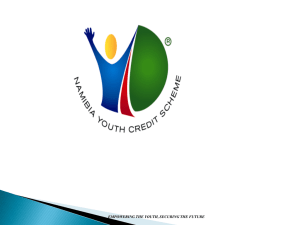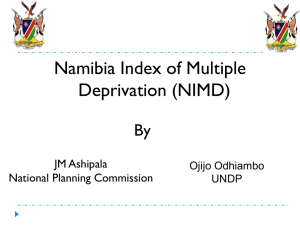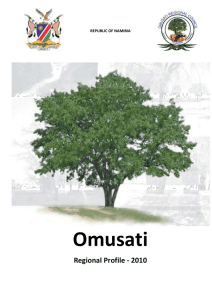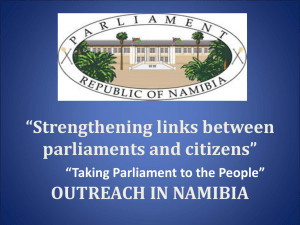view documents
advertisement
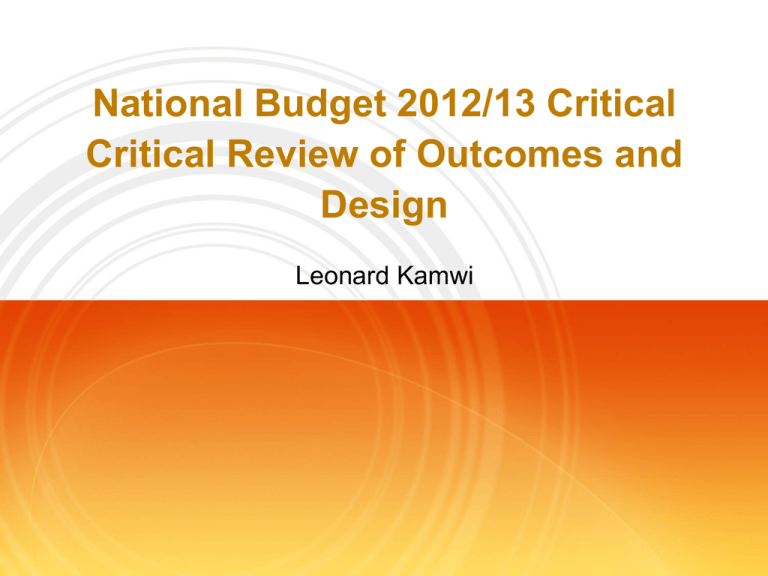
National Budget 2012/13 Critical Critical Review of Outcomes and Design Leonard Kamwi Outline 1. A Glance 2. Macroeconomic Assumptions 3. Fiscal Stance 4. Spatial Picture of Unemployment Numbers 5. How Targeted are the Investments? Page 2 Glance Coming to the details of the budget, it is not an expansionary budget but simply one that blotted in size. Size of the budget is N$40.2 billion against N$37.1 billion last year. The biggest heads of expenditure are as follows: Education: N$9.2 billion or 23.4% of the total outlay Health: N$4.0 billion or 9.9% Defence: N$3.4 billion or 8.5% Finance: N$3.3 billion or 8.2% Transport: N$2.5 billion or 6.2% Police: N$ 2.4 billion or 5.9% Interest Payments: N$2.2 billion or 8.3% Against a total outlay of N$40.2 billion, the budget forecasts total revenue at N$35.4 billion, leaving a fiscal deficit of N$4.7 billion which is 4.6% of the gross domestic product (GDP). It will be met through Cash Reserves of N$2.6 billion, net external financing of N$860 million, domestic borrowing of N$2.1 billion. Coming to the Revenue side, realistically speaking, though unfortunately, the taxes to be collected are heavily skewed towards SACU N$13.8 billion. Key Themes “Doing more with less”: “Gradual withdrawal of significant fiscal expansion” “Fiscal Sustainability”: Fiscal rules are redefined “Reorienting TIPEEG” and an acknowledgement is made that we are close to the limits. Page 3 Expenditure by Vote Anti-Corruption Commission Auditor General National Planning Commission Electoral Commission Home Affairs and Immigration Lands and Resettlement President Prisons and Correctional Services Foreign Affairs Environment and Tourism Trade and Industry Labour and Social Welfare Agriculture, Water and Forestry Transport Defence Education - Page 4 2,000,000,000 4,000,000,000 6,000,000,000 8,000,000,000 10,000,000,000 Development Budget by Vote Electoral Commission Veterans Affairs Labour and Social Welfare Auditor General National Planning Commission Fisheries and Marine Resources Youth, National Service, Sport and Culture Finance Information and Communication Technology Foreign Affairs Lands and Resettlement Police Trade and Industry Regional and Local Government, Housing and Rural Development Public Safety Agriculture, Water and Forestry - Page 5 400,000,000 800,000,000 1,200,000,000 Macroeconomics Assumptions Staying conventional, for now GDP Growth & Inflation The other macroeconomic assumption of note in the budget is lower GDP inflation. The nominal GDP projections imply an average GDP inflation of around 6.0% over the MTEF. While this may be conservative, the strong real growth assumption 4.7% average in the budget has implications for monetary policy, with consequence that the authorities may be understating the debt servicing costs. Page 6 2013 2014 Growth 4.4% 4.8% 4.90% Revenue Growth 2012 2013 2014 2.00% 31.6% -0.5% 12.5% 50.0% 40.0% Realistic! Real GDP 2012 All in all the macroeconomic assumptions are realistic. The growth prospects gives a reassuring view of the future of Namibia’s public finances than last year’s budget with nominal spending capped over the coming three years, progressively smaller deficits and lower overall debt. 30.0% 20.0% 10.0% 0.0% 1991/92 1994/95 1997/98 2000/01 2003/04 2006/07 2009/10 2012/13 -10.0% -20.0% Non-Trade Tax Revenue Growth Ralf Preusser ·02 March · page 6 Nominal GDP Growth Fiscal Stance Gradual withdrawal of fiscal expansion! Probably Still expansionary! If the execution rate in 2011/12 comes in at less than 90% or N$33.4 billion of last year’s proposed outlay, then spending of N$40.2 billion implies a 20.4% growth over the previous. By Any measure that is a huge increase. Doing more with less? • The outlays are not less than anything seen before, the increase is just less than last year. Page 7 Although there is a notable change in the fiscal priorities as highlighted in the speech, there is no commensurate change in the direction of spending. Spending is still heavily directed towards the social sectors. The strategy appears to be, to give the economy a big push in 2012/13 then retrace a little in year two, perhaps to gather momentum, then increase spending by a huge margin again in year three. Although the rationale for this is not clear, it is indeed the same pattern we observed in the prior MTEF. The only other thing we have observed is that, when the second year finally arrives, the allocations get revised upwards again such that an exponential trend is created. Ralf Preusser ·02 March · page 7 Figure : Sectoral Allocations Source: Ministry of Finance Page 8 More specifically, a additional funds are directed towards the interventions outlined in Table How Targeted are the expenditures and Investments? Page 9 Some Stylized Facts Unemployment: 51.2% ranks 192 › Highest in predominantly communal areas of Ohangwena, Omusati, Oshikoto, Kavango & Caprivi › Unemployment is also highest among women, the youth and unskilled or trained GDP - composition by sector: › agriculture: 9.6% › industry: 34.2% › services: 56.2% (2010 est.) Labor force - by occupation: › agriculture: 16.3% › industry: 22.4% › services: 61.3% (2008 est.) Unemployment Spell: 70% of unemployed in 2008 were searching for 2 yrs or more. In 2004, the rate was 48.7% Page 10 Unemployment by Region Erongo Khomas Karas Hardap Otjozondjupa Omaheke Oshana Kunene Namibia Caprivi Oshikoto Okavango Ohangwena 32.60 33.50 36.40 38.60 43.80 48.20 48.80 50.40 51.20 65.60 68.60 70.00 76.40 Omusati 78.60 Predominatly communal areas have highest unemployment. Observation is consistent with declining employment from communal agriculture Participation rate by region? Oshana has a slitely high urban population compared to other "O" regions Page 11 EMPLOYMENT Cont. Employment status Employment in some occupations › Employees 269,602 (81.3%) › Elementary occupation 77,571 (23.4%) › Other own account workers (without paid employees) 34,402 (10.4%) › Service, shops & market sales workers 61,144 (18.4%) › Other employers (with paid employees) 10,965 (3.3%) › Craft & Trade workers 52,617 (15.9%) › Subsistence farmers (without paid employees) 6,824 (2.1%) › Skilled agricultural & fishery workers 29,185 (8.8%) › Subsistence farmers (with paid employee) 4,541 (1.4%) › Professionals 28,692 (8.7%) › Unpaid family workers (subsistence/communal farms) 3,211 (1.0%) Some Constraints › Clerks 22,877 (6.9%) › Technicians & Associate professionals 21,639 (6.5%) › Skills Mismatch due to Low Education Attainment › Structure of the Economy: Growth emanates or high school drop out rates. This decreases from Capital Intensive Sectors. GDP is produced probability of being Employed even by self but also by machines not much by people. New Growth leads to a lack of Innovation and entrepreneurship. Path that is Labor Absorptive requires a focus on Educational system Reform is Key. Poor manufacturing, infrastructure development, rural Entrepreneurship!!! development and agro-processing, and the "green" › Size of Domestic Market: 2 m people of which economy. 55% survive on less than US$2 per day. The need to focus on Labour Intensive export oriented › Low productivity in Agriculture (People still use sectors (Agriculture, Construction) vs Capital ox and donkeys to plough). Invest in machines Intensive Export oriented sectors (Mining, Manufacturing) Page 12 To what extent does allocation resemble region poverty / unemployment profile? Development Budget by Region Agric Development Budget by Region Otjozondjupa Otjozondjupa Oshikoto Oshikoto Oshana Oshana Omusati Omusati Omaheke Omaheke Ohangwena Ohangwena Kunene Kunene Khomas Khomas Kavango Karas Kavango Hardap Karas Erongo Hardap Caprivi Erongo Abroad Caprivi 0 Page 13 2,000,000 4,000,000 6,000,000 8,000,000 0 500,000 1,000,000 1,500,000 2,000,000 2,500,000 To what extent does allocation resemble region poverty / unemployment profile? Transport Development Budget by Region Otjozondjupa Enviro & Tourism Development Budget by Region Oshikoto Otjozondjupa Oshana Oshikoto Omusati Oshana Omaheke Omusati Ohangwena Omaheke Ohangwena Kunene Kunene Khomas Khomas Kavango Kavango Karas Karas Hardap Hardap Erongo Erongo Caprivi Caprivi 0 Page 14 20,000 40,000 60,000 80,000 100,000 120,000 N$'000 0 10,000 20,000 30,000 N$'000 40,000 50,000 Questions and Discussions
